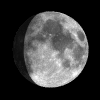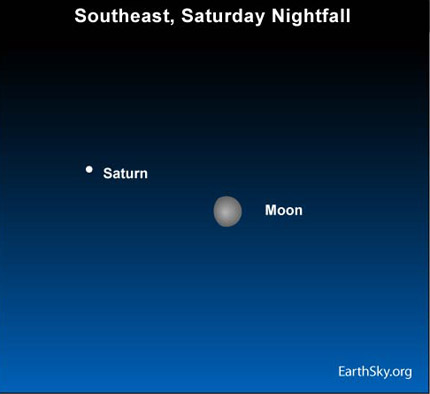Courtesy of EarthSky
A Clear Voice for Science
www.EarthSky.org

 Tonight, the oval-shaped waxing gibbous moon shines close the ringed planet Saturn. At this time yesterday, a somewhat thinner waxing gibbous moon shone close to Regulus, the brightest star in the constellation Leo the Lion.
Tonight, the oval-shaped waxing gibbous moon shines close the ringed planet Saturn. At this time yesterday, a somewhat thinner waxing gibbous moon shone close to Regulus, the brightest star in the constellation Leo the Lion.
Why has the moon moved? The fact is that – every day – the moon travels about 13 degrees eastward in front of the backdrop stars. (The moon’s diameter equals about 1/2 degree, and your fist held at an arm length from your eye spans roughly 10 degrees of sky.) This motion is due to the moon’s actual motion in orbit around Earth. Although the Earth’s rotation causes the moon and stars to drift westward across the sky throughout the night, the moon’s orbital motion continually propels the moon eastward through the stars.
Almost all night tonight, the moon can guide your eye to the planet Saturn, the solar system’s 2nd largest planet and the 6th planet outward from the sun. Remember the number 9.5 and you have Saturn’s vital statistics at your fingertips. Saturn’s diameter is about 9.5 times greater than the Earth’s diameter, and Saturn lies some 9.5 times the Earth’s distance from the sun.
Saturn – the ringed planet – is the gem of the solar system. Usually, this world’s glorious rings can be seen quite easily through a small telescope. Right now, the northern side of Saturn’s rings is tilted less than 3 degrees toward Earth. The tilt will shrink to less than 2 degrees by June. Thereafter, the inclination of Saturn’s rings will slowly but surely increase again. By December 2010, the northern side of the rings will be more than 9 dgrees tilted. By October 16, 2017, the rings will be the widest open, tilting some 27 degrees toward Earth.
Written by Bruce McClure
Astronomy Picture of the Day from NASA/JPL
U.S. Naval Observator Astronomical Information center